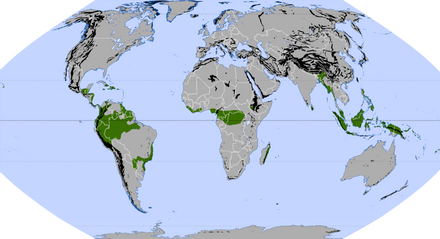Always humid tropics
The zone of the ever-humid tropics is one of the nine global eco-zones according to J. Schultz. Today it occupies about 8.4% of the earth's land surface. At the beginning of the 21st century, around 50% of them are largely in a near-natural state .
It is part of the tropical climate zone and is almost exclusively around the equator . Depending on the prevailing vegetation, it can still be subdivided into the landscape types tropical rainforest (lowlands and mountains up to 2000 m) and cloud and cloud forest (over 2000 m).
The boundaries of the ever-humid tropics are in reality fluid, so that an exact extent - as shown on the map - cannot in fact be determined. This fact becomes understandable if one uses comparable geozonal models , e.g. T. have significant deviations. For example, consider the comparable zonobiom of the tropical rainforest areas on the map of the zonobiome according to Walter and Breckle or the FAO Ecozones .
climate
The always-humid tropics are, sharply defined, the part of the tropics with a maximum of three arid months per year. This means that in at least 9 out of 12 months the rain will exceed the possible evaporation . Accordingly, soil and air humidity are quite high all year round. This promotes the activity and growth of the plants, which usually show either no or at least no common resting phase.
Since both temperature and rainfall fluctuate little over the year in these regions , the always humid tropics are characterized by a great uniformity of the climate . Climatic seasons are largely absent, rather one speaks of a pronounced daytime climate .
The always-humid tropics are surrounded by or merge into the summer-humid tropics .
Individual evidence
- ↑ J. Schultz: The ecological zones of the earth. Ulmer, Stuttgart 2008, ISBN 978-3-8252-1514-9 .
- ↑ Values from J. Schultz (Schultz, J. (2008): Die Ökozonen der Erde. Stuttgart) without Antarctica and Greenland converted to the entire land surface. See the article Eco zone # The individual eco zones . (See also tabular overview of various landscape zone models and their proportions ; PDF; 114 kB)
- ↑ Map data for the studies "Last of the wild", "Intact forest landscapes" and "Review of status and conservation of wild land in Europe", summarized in the source description for the "Wilderness World Map" on Wikimedia Commons
literature
- J. Schultz: The Earth's Eco Zones. 5th edition. Ulmer, Stuttgart 2016. ISBN 978-3-8252-4628-0 .
- J. Pfadenhauer, F. Kötzli: Vegetation of the earth. Springer Spectrum, Heidelberg 2014. ISBN 978-3-642-41949-2 .
- W. Zech, P. Schad, G. Hintermaier-Erhard: Soils of the world. 2nd Edition. Springer Spectrum, Heidelberg 2014. ISBN 978-3-642-36574-4 .
